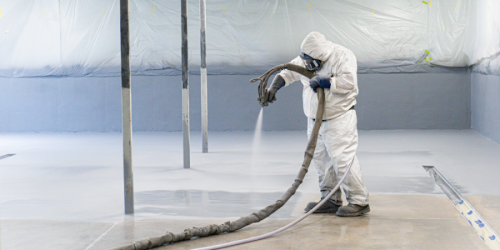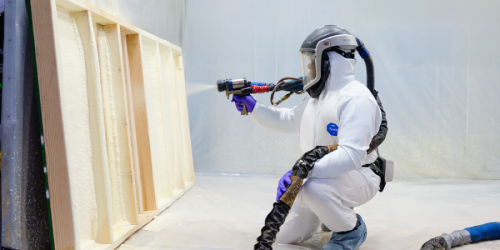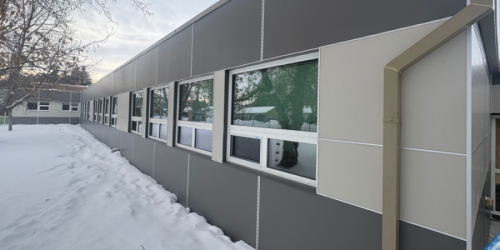Q&A Forums
Mold and condensation Post New Topic | Post Reply
| Author | Comments |
|---|---|
|
Gary Nochajski
Posted: Nov 24, 2008 07:11 AM
|
Mold and condensation
We own an old theater in the Buffalo New York area, I will be hiring a contractor to spray 1/2 lb foam, last week upon inspection of the roof deck I noticed mold growth and condensation in an area where a roof cupola is (about 200 sq ft affected area. My question is does this spray foam eliminate existing mold or does it encapsulate it to encourage continued growth? At this time I have 3 contractors check out this job; I can not get a satisfactory answer; one that comes close and makes sense to me recommends that I get some heat up there to dry out the deck and perhaps even a dehumidifier then scrub the mold off with some sort of mold eliminator.
|
|
mason
Posted: Nov 25, 2008 11:20 AM
|
Sprayfoam will not eliminate mold that is already there. You need to treat that first before spraying the foam. Sprayfoam does not provide a food source for mold but will not stop its spread. |
|
Gerry Wagoner
Posted: Nov 28, 2008 09:28 AM
|
Mold fervor is cyclical. These things come around and there is a big bugaboo, then it calms down. If a surface is suitable to spray to it can be encapsulated with Insulstar or another antimicrobial foam product. According to Roger Morrison and a forestry professor from the University of North Carolina, closed cell spray foam will kill surface mold in two ways. The mold cannot survive the exothermic heat generated by the foam reaction, and it is suffocated/isolated by the finish product. Here is what they learned. - Mold needs temperature & moisture to survive. - Needs air. - Encapsulating with foam stops it. - We have expert opinions & testing. No current formal data. NCFI did some testing with petri dishes under the oversight of this professor. In summary, the foam won and the mold lost. og |
|
mason
Posted: Nov 28, 2008 12:32 PM
|
Theory sounds good, however, in real life I have seen sprayfoam installed over moldy wood and the mold continue to spread. A couple of things can determine whether this happens. The foam may not encapsulate all of the wood surfaces allowing the mold to grow where the foam is not. Also, the foam may separate or crack slightly in places allowing moisture to get to the mold allowing it to spread. Best way to stop it is to treat the wood first with a bleach type product. If you sell the foam as a mold treatment be prepared to defend yourself in court eventually if mold ever is found in the house. Remember the asbestos claims of the 70s and 80s and be cautious. |
|
William Gibson
Posted: Dec 03, 2008 07:24 AM
|
Mason: Have you had instances where the Foam took on a chemical reaction with the mold-treating agent. We've had a job that we had horrible shrinkage after a customer had sprayed an agent to clean existing mold. Not knowing, we went in and did our job after the cleaning was done. Months down the road the customer was calling us to come back because infrared was picking up cold areas. Turned out the foam had shrank in the spots that the agent was applied. |
|
mason
Posted: Dec 06, 2008 09:13 AM
|
I have seen foam shrinkage on a few jobs that I could not determine the specific cause. I am skeptical however that a mold agent would react with the foam due to a chemical reaction. It may however, have made the substrate damp enough to affect the mix ratio thereby causing a slightly B rich foam with lower dimensional stability. It is easy to test yourself if there is a reaction. Treat a small section of wall with the mold agent. Let it dry and spray some foam on it. Then spray some foam on another section that was not treated. Obtain samples of the foam from the treated and non-treated area. Check the density,compressive strength and cell structure of the 2 samples. If they vary considerably, you have found a causal link. If not, you need to look elsewhere. Note: Foam is more likely to shrink when you install it in thicker lifts. to minimize the potential for foam shrinkage, apply a first pass of 0.5 to 0.75 inches first in a picture frame pattern to the studs and substrate. Then let if set for 10-15 minutes and bring the foam up to thickness with lifts no greater than 1.5 inches. Again wait 10-15 minutes between lifts (or longer if manufacturer recommends it). This technique will create a layer of foam next to the studs with a high density skin that should minimize movement and shrinkage. And if there is cracking, it would more likely be limited to the first layer and not the succeeding layers. |





























